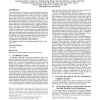Free Online Productivity Tools
i2Speak
i2Symbol
i2OCR
iTex2Img
iWeb2Print
iWeb2Shot
i2Type
iPdf2Split
iPdf2Merge
i2Bopomofo
i2Arabic
i2Style
i2Image
i2PDF
iLatex2Rtf
Sci2ools
GLVLSI
2009
IEEE
2009
IEEE
Enhancing bug hunting using high-level symbolic simulation
The miniaturization of transistors in recent technology nodes requires tremendous back-end tuning and optimizations, making bug fixing at later design stages more expensive. Therefore, it is imperative to find design bugs as early as possible. The first defense against bugs is block-level testing performed by designers, and constrained-random simulation is the prevalent method. However, this method may miss corner-case scenarios. In this paper we propose an innovative methodology that reuses existing constrainedrandom testbenches for formal bug hunting. To support the methodology, we present several techniques to enhance RTL symbolic simulation, and integrate state-of-the-art word-level and Boolean-level verification techniques into a common framework called BugHunter. From case studies DLX, Alpha and FIR, BugHunter found more bugs than constrained-random simulation using fewer cycles, including four new bugs in the verified design previously unknown to the designer. The results ...
Constrained-random Simulation | GLVLSI 2009 | RTL Symbolic Simulation | Symbolic Simulation | VLSI |
| Added | 21 May 2010 |
| Updated | 21 May 2010 |
| Type | Conference |
| Year | 2009 |
| Where | GLVLSI |
| Authors | Hong-Zu Chou, I-Hui Lin, Ching-Sung Yang, Kai-Hui Chang, Sy-Yen Kuo |
Comments (0)

